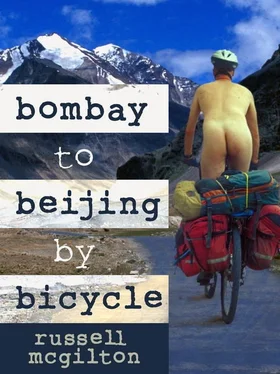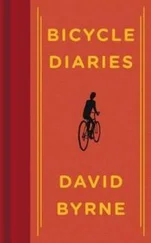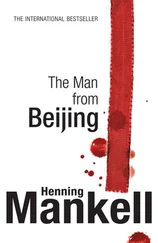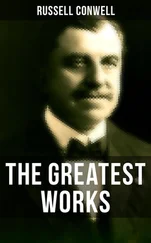Built in the 12th century by Raja Bhillamraj, Daulatabad is a fortress carved out of a cliff face. But the fortress wasn’t known merely for this natural geological feature: it was infamous for its array of booby traps, moats, unclimbable walls and sheer sadistic ingenuity. It was the whispered talk of soldiers’ nightmares, a veritable hell, and was thought for many years to be impregnable until the Sultan of Delhi invaded it in 1308. Even today it seems an impossible accomplishment, and I was mindful of this as my guide led me past two huge doors with long horizontal spikes.
‘These are to stop elephants charging,’ said the guide. ‘But the enemy is thinking it is possible to get in, so they sacrifice camels onto the spikes. But once past here they have two doors; one big one and a smaller one. Of course, the enemy thinks that he must take the bigger one, as surely this is the way into the city. But no, my friend. It is a trap. It is a dead end and men with hot oil lay in wait for them. Notice the path as we go? It is staggered in steps and turns so that the elephant cannot get a run up.’
We continued on and he directed me onto a shaky ladder leading up a turret. He remained on the ground and called up to me.
‘You see the cannon? See how beautifully carved it is? It is the Kila Shikan. You see that the cannon can only be moved 180 degrees. This is so that if it were captured it could not be turned and used on the palace. They think of everything!’
Down a small tunnel, a torchbearer led the way over steps.
‘If they got past the gates and the cannon and the hot oil and then went down into these caves, they would find themselves impaled on spikes laid on the steps.’
He said something to the torchbearer, who then blew out the light, leaving us in complete darkness.
‘Imagine trying to attack your enemy and you cannot see him? Here there are two tunnels. The enemy think they go in different directions, but no. They connect and so they end up killing each other. Magnificent, yes?’
The torchbearer flicked a match and we could see again. A window of light shot into the middle of the darkness.
‘Once they had realised they were killing each other, they would stop then head to this light. As their eyes tried to adjust to the light, the palace guards would attack them. Very clever!’
The guide led me out of the cave through a narrow opening.
‘See how you have to move your head out first? A guard would be standing here to chop your head off. Come.’
‘Not exactly The House of Fun, is it?’
‘Oh, no, no, no! Tis not fun!’
We were outside now, the sun blinding.
‘The palace is on the top of that cliff; it has been carved flat so that iguanas could not climb up.’
‘Iguanas?’
‘Yes, they were used to secure ropes for the men. But this is too steep for them; no grip with the claw. In the moat they kept the crocodiles. You had to cross it to reach the Bala Kot citadel. At the top you can see the Baradi residence of the queen, Yadavi. You may go to the top. I am an old man, as you can see, so I will not join you. Goodbye and I hope you enjoy India.’
The ‘old man’ turned and bounced vigorously down the narrow steps. Perhaps it wasn’t the several flights of stairs that had sent him packing but the rush of loud, happy schoolchildren tearing down towards me. They pushed past, laughing and pointing at me and my big, cumbersome SLR camera.
Some years after the first invasion, the Sultan Muhammad Tughlak ascended the Delhi throne. Tughlak was so impressed with nasty little Daulatabad that he ordered the entire population of Delhi to move to the new capital. No one was exempt, and thousands died on the way. Fifteen years later the Sultan, having had his fill of this place, suddenly changed his mind about the new address and ordered the whole population to move back to Delhi.
Outside the fortress, I went to my bike, which I had left locked up at a police traffic gazebo and in the care of three boys hawking gifts.
‘Hello, sir. Look, special trinket,’ one of them said, showing me a small gold carving. ‘Key ring,’ he said. A closer look revealed a man thrusting into a woman from behind.
‘Cute,’ I said. ‘But will it unlock my bike?’
I swung my leg over the bike and got as far as the small farming town of Phulumbria, where trucks laid siege to a large paddock of cut sugar cane, their trays overflowing like stuffed scarecrows. I found the only hotel in town, which was run by a man with a cyst the size of a golf ball under his chin. Later, in the restaurant, he served me spicy dahl in the dim flickering light of a solitary kerosene lamp.
‘Yes…’ He leered, his cyst waggling back and forth like a hypnotic metronome, his eyes never leaving me while I ate. ‘ Yeees .’
* * *
The ride out of Phulumbria was flat at first, but then as I neared the Ajanta Caves it became quite hilly and I was forced to slog up a long, arduous slope, sweating and groaning in India’s springtime heat, which was already uncomfortable by nine a.m. I could only wonder what it would be like when summer finally arrived in April, just over two months from now.
More emptiness greeted me when I reached the top. I coursed down the hill, the rush of warm air cooling me, to the entrance of the Ajanta Caves. Built in the same period as the caves of Nasik, the Ajanta Caves were said to be the most detailed Buddhist caves in the world.
At the cave’s entrance, Indian tourists flocked around souvenir shops, drink sellers and samosa stalls. I decided to leave my bike somewhere and pay someone to look after it, but no one wanted a bar of it, not even the bag handler with a big stick and attitude to match. A sign read ‘UNLOCKED BAGS WILL NOT BE CHECK IN’, and, as my panniers were unlockable, he wouldn’t take them.
‘Where am I supposed to put them, then?’
His explanation was a hefty wave of his stick, so I was left with one option: stay the night at the Ajanta Hotel.
I took a single room and slept for two hours, avoiding the afternoon heat. Upon venturing out, I came across a large man. He was deeply lined, grey-moustached, with a yellow turban around his head and a large stomach protruding from his camel safari suit. When I asked to take his photograph his grey moustache shot out either side like antennae.
‘Forty rupees!’ he demanded.
‘Really?’
‘People from all over the world – Holland, Denmark, Germany – come to see me and they pay,’ he said, hand to the side, in a half wave.
I politely declined and instead took photos of grey haired and black-faced langur monkeys, hanging lazily from the trees above. Named after the Hindu monkey god, Hanuman, they are sacred in India and thus left alone. This fact, however, was lost on a group of rowdy children who took pleasure at throwing stones at them. The monkeys barked to life and took off, leaping on to the rocks, their grey tails propelling them.
Though the afternoon sun had peaked, the rock face of the caves radiated an intense heat, and I took cover in the coolness of a deep cave. This was just one of the 28 caves that had been carved out by hand as a permanent place of worship for the monks, supposedly to protect them from the heavy monsoons.
This particular cave housed various murals. Flaking away from centuries of neglect and recent attempts to restore it, one mural showed sailors being seduced by Sirens who later devoured them; on another mural, limbs and heads were being cooked in pots. This wasn’t exactly the sought of thing I expected to see in a Buddhist monastery, and I half-wondered whether these horrid images were perhaps intended to scare off unwelcome guests (notably school children, who were now testing the reverberations of the cave with high-pitched squeals). Apparently these murals told the story of Buddha’s past lives to illustrate certain virtues (I would have thought that eating each other was an obvious no-no, but perhaps some wayward monk had grown tired of vegetarianism and decided to have a chomp on someone).
Читать дальше












